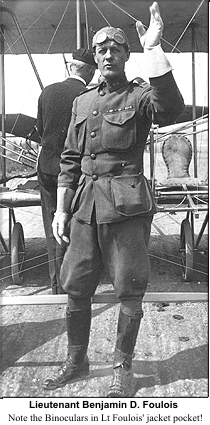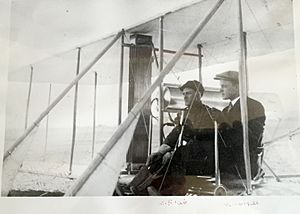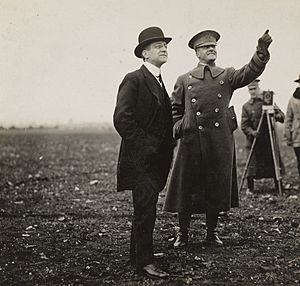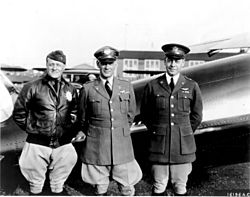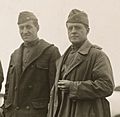Benjamin Foulois facts for kids
Quick facts for kids
Benjamin Delahauf Foulois
|
|
|---|---|
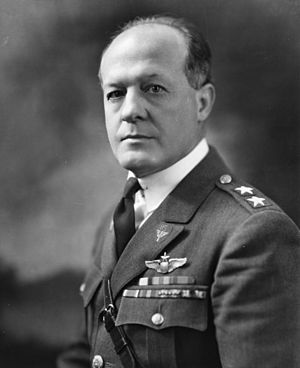
Benjamin D. Foulois
|
|
| Born | December 9, 1879 Washington, Connecticut |
| Died | April 25, 1967 (aged 87) Andrews Air Force Base |
| Place of burial | |
| Allegiance | |
| Service/ |
|
| Years of service | 1898–1935 |
| Rank | |
| Commands held | Chief of the Air Corps Chief of the Air Service, AEF 1st Aero Squadron |
| Battles/wars | Spanish–American War Philippine–American War Pancho Villa Expedition World War I |
| Awards | Distinguished Service Medal French Légion d'honneur (Commander) Order of the Crown of Italy (Grand Officer) Congressional Air Force Medal of Recognition |

Benjamin Delahauf Foulois (December 9, 1879 – April 25, 1967) was a United States Army general. He learned to fly the first military planes bought from the Wright brothers. He became the first military pilot to fly an airship. He also achieved many other "firsts" in military aviation. He played a key role in developing the Air Force in the United States.
Contents
Early Life and Military Service
Joining the Army
Benjamin "Benny" Delahauf Foulois was born on December 9, 1879, in Washington, Connecticut. When he was 18, he joined the Army to help in the Spanish–American War. He arrived in Puerto Rico just before the war ended.
After five months, he returned home. On June 17, 1899, Foulois joined the Army again. He served in the Philippines and became a second lieutenant in 1901. He helped survey and map areas there.
Learning About Airships
Foulois attended military schools to improve his skills. In 1908, he joined the Signal Corps. He wrote a paper about the future of dirigible balloons and airplanes in warfare. He believed airplanes would replace horses for reconnaissance (scouting). He also thought planes would have wireless communication and send photos.
Because of his ideas, Foulois was chosen to test early airships and airplanes. He became the first military crewman on an airship in August 1908.
Early Military Aviation (1908–1916)
First Military Flights
Foulois's first aviation job was with the Aeronautical Division, U.S. Signal Corps. He flew the U.S. government's first dirigible balloon. After a year, he realized that airships were not the future for military use. He suggested the Army stop buying them.
The Wright brothers improved their airplane after a crash in 1908. In July 1909, Orville Wright was ready to test the plane for the Army. Foulois took his first flight in an airplane on July 30, 1909. He flew with Orville Wright from Fort Myer to Alexandria, Virginia. They set new records for speed, altitude, and distance. The Army bought this plane, which became "Signal Corps No. 1."
The contract required the Wrights to train two pilots. Foulois was one of them. He learned to handle the controls but did not solo at first.
Flying in Texas
In 1910, Foulois was sent to Fort Sam Houston in San Antonio, Texas. He was told to "teach yourself to fly." On March 2, 1910, he made his first solo takeoff and landing. He also had his first crash that day.
Over the next year, Foulois made important changes to the plane. He added wheels instead of skids, so it didn't need a launch rail. He also invented the first airplane seat belt. He used a leather strap from the cavalry to keep himself in the seat.
In 1911, Foulois and pilot Philip Parmalee made the first official military reconnaissance flight. They flew over Texas, looking for Army troops.
Becoming a Military Aviator
In 1912, Foulois became the fifth Army pilot to be called a "Military Aviator." This was a special rating for military pilots.
In 1913, he returned to aviation duty. He became the commanding officer of the 1st Company of the 1st Aero Squadron in San Diego, California. Later, he became the squadron commander.
In 1914, Foulois and other pilots said that "pusher" aircraft (where the propeller is behind the engine) were unsafe. The Army then grounded these planes.
In 1915, Foulois led the 1st Aero Squadron on a long flight from Oklahoma to Texas. In 1916, he was ordered to take eight airplanes to Mexico. This was to help General John J. Pershing find Pancho Villa. On March 16, 1916, Foulois made the first American military reconnaissance flight over foreign land. However, most of the planes were destroyed within eight weeks due to the harsh conditions.
World War I Service
From March to September 1917, General Foulois was in charge of all American aviation equipment and personnel in the United States. He worked to get funding for more squadrons, balloons, and aviation schools. On July 24, 1917, he was promoted to temporary Brigadier General. This allowed him to oversee this huge responsibility.
In October 1917, Foulois moved to France. He was in charge of the Air Service for the American forces there. He also joined committees to coordinate aviation efforts with other Allied countries.
There was some disagreement between Foulois and Billy Mitchell, another important aviation leader. Foulois was focused on building up the Air Service and its supplies. Mitchell was more focused on combat operations. Despite their differences, both played a big part in developing the Air Force.
In April 1918, Foulois asked to be relieved from his position as Chief of Air Service. He recommended that Major General Mason Patrick replace him. Foulois then became Patrick's assistant. He later took on roles to help organize supplies and communication for the Air Service.
Becoming Chief of the Air Corps
After World War I ended in November 1918, Foulois helped draft the aviation parts of the Treaty of Versailles. When he returned to the U.S. in 1919, he was in charge of settling war claims. He was promoted to major in 1920 and transferred to the Air Service.
Foulois spoke to Congress many times about the future of aviation. In 1920, he was sent to Europe as an assistant air attaché. He gathered a lot of information about German aviation by talking to pilots and collecting documents. He hoped this information would be used in America, but much of it was not.
In 1925, Foulois took command of Mitchel Air Force Base in New York. In 1927, he became one of the three Assistant Chiefs of the Air Corps. This gave him the temporary rank of brigadier general.
In May 1931, he led a large Air Corps exercise with 672 airplanes. This exercise included defense flights and combat practice. For his leadership, Foulois won the Mackey Trophy for the best military flight of 1931.
On December 19, 1931, President Herbert Hoover appointed Foulois as Chief of the Air Corps. This gave him the rank of major general. During his four years in this role, he often spoke to Congress about the Air Corps' future. He worked to secure funding during a time of economic hardship.
Foulois and other Air Corps leaders pushed for the development of long-range bombers in 1933. This led to the creation of planes like the B-17 and B-24. These planes were very important for the Air Force to eventually become a separate branch of the military.
Air Mail Service (1934)
In 1934, the Air Corps was asked to deliver the U.S. mail. This happened because of issues with commercial airlines' mail contracts. Foulois agreed to this task, even though the Air Corps was not fully ready for it. They lacked training, equipment, and experience for flying in winter conditions.
Air Corps pilots flew over 1.5 million miles. However, there were many fatal crashes. This event showed the challenges the Air Corps faced. It also highlighted the need for better training and equipment. This experience helped lead to recommendations for a stronger Air Force.
Retirement and Later Life
Foulois retired from active duty on December 31, 1935, after 36 years of service. He retired with the rank of Major General. He had warned about Germany building up its air power and the need for a strong U.S. air force.
Before World War II, he led New Jersey's civil defense program. He continued to speak and write about national security.
In his eighties, Foulois traveled extensively by air. He spoke to U.S. Air Force members around the world about national security.
In 1963, Foulois appeared on the TV show I've Got a Secret. His secret was that he had once been the entire U.S. Air Force!
General Foulois died on April 25, 1967, at age 87. He was buried in his hometown of Washington, Connecticut. He had worked on a biography of his life, which was published after his death.
Foulois lived to see the Apollo Program take steps into space. His many "firsts" in aviation helped pave the way for future advancements. He is remembered as a very important figure in the development of U.S. air power.
Pronunciation of Foulois
General Foulois said his name rhymes with "to cloy" and is pronounced "foo-loy."
Legacy
- General Foulois was honored in the National Aviation Hall of Fame in 1963.
- He is a member of the Military Intelligence Hall of Fame.
- The Foulois House, a lodging facility at Fort Sam Houston, Texas, is named after him.
- The Benjamin D. Foulois Creative and Performing Arts Academy in Morningside, Maryland, is named in his honor.
- He received the Golden Plate Award from the American Academy of Achievement in 1965.
Images for kids
-
Legion of Honour medal


